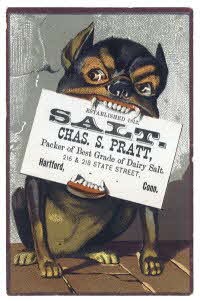See also articles: Salt of the Earth 1 and Salt of the Earth 2
SALT

Salt may have been a large factor in determining the success of various societies and even the amount of freedom its citizens had. Where salt was scarce, strong, controlling rule prevailed to ensure the availability of salt to all, but where salt was plentiful the need for strong government was not as great, and citizens had more freedom.
Only 6% of the salt used in the U.S. is used in food; another 17% is used for de-icing streets and highways in the winter months.
In the late 17th century, salt was the leading cargo carried from the Caribbean to North America (most tonnage). Salt Cod was the leading cargo carried from North America to the Caribbean. It was used to feed slaves on sugar plantations.
In the early 1800s salt was 4 times as expensive as beef on the frontier - it was essential in keeping people and livestock alive.
Common salt, sodium chloride, is sold in several different particle sizes (gradation) and forms, depending on the intended end use. Discrete crystals can be seen in rock salt used for deicing. Fine granules are typical of table salt and even finer popcorn salt. Kosher salt, pickling salt and ice cream salt are slightly coarser. Small compressed pellets are used in water softeners and large salt blocks are used as salt licks for livestock. When viewed under strong magnification, all sodium chloride is crystalline. Very large cubic crystals, of two, three or more inches in size, can be seen in some salt mines. They are transparent and cleave into perfect cubes when struck with a hard object.
Salt Institute
Salt preserves foods by creating a hostile environment for certain microorganisms. Within foods, salt brine dehydrates bacterial cells, alters osmotic pressure and inhibits bacterial growth and subsequent spoilage. Salting fish made long-range explorations possible in the age of sailing ships.
Cream will whip better better if you add a pinch of salt.
You are here > Home > FOOD TRIVIA & FACTS >
Please feel free to link to any pages of FoodReference.com from your website.
For permission to use any of this content please E-mail: james@foodreference.com
All contents are copyright © 1990 - 2025 James T. Ehler and www.FoodReference.com unless otherwise noted.
All rights reserved. You may copy and use portions of this website for non-commercial, personal use only.
Any other use of these materials without prior written authorization is not very nice and violates the copyright.
Please take the time to request permission.
FOOD TRIVIA and FOOD FACTS
Also see: Food Articles and Cooking Tips
Popular Pages
Home | Articles | FOOD TRIVIA | Today in Food History | Food Timeline | Recipes | Cooking_Tips | Food Quotes | Who’s Who | Culinary Schools & Tours | Food_Trivia_Quizzes | Food Poems | Free_Magazines | Food Festivals & Events
FoodReference.com (since 1999)
FOOD TRIVIA and FOOD FACTS SECTION

